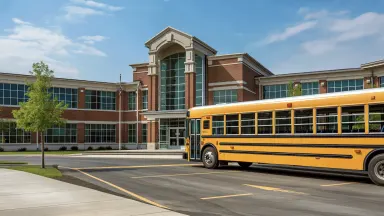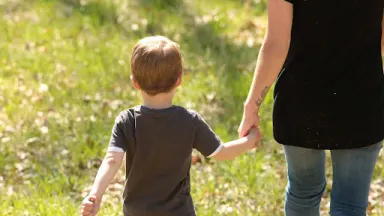School Safety: Enabling Law Enforcement Response During a Lockdown
When seconds matter, it’s crucial to make every one count.
During our recent interview with Pat Hamilton, Alliance Director at The “I Love U Guys” Foundation, he told us that school staff need to be prepared to own the first five minutes of any crisis. The other half of the life-saving equation lies with law enforcement response.
The “I Love U Guys” Foundations’ Standard Response Protocol (SRP) is designed to empower schools with five specific, easy-to-follow actions that can be performed during any incident to rapidly address the situation and mitigate associated risks. One of the five SRP protocols, Lockdown, is used to secure individual rooms and keep occupants quiet and in place in the event of an active on-campus threat.
Pat Hamilton underscored the brutal reality of active threat events: they are fast. Data shows that 70% of active threats are resolved within five minutes, and 90% within 10. As Pat said, seconds matter.
Since Columbine, a tragic history of mass violence in the U.S. has caused police to fundamentally reshape how they respond to active threats. Today, officers are trained to take immediate action to confront and neutralize a threat as quickly as possible.
Law enforcement response times to active threat events have significantly shortened—from an average of nearly an hour in earlier cases to just a few minutes in many recent incidents. While we’ve seen cases where hesitation or poor coordination cost lives, and those moments remain painful reminders of what’s at stake, many have showcased the incredible heroism of law enforcement, with officers running directly into danger to save strangers.
Recognizing the speed of these events, the question becomes: how can schools help law enforcement respond even more intelligently? There are several tactics, tools, and technologies that schools can implement ahead of time to better enable responding officers, increasing the speed and efficiency with which they can restore safety.
1) Minimize Confusion: Adopt a common lexicon for clear and coordinated emergency communications
One of the simplest, yet most effective tools available to staff, students, and first responders is a shared language.
“You could have a high school on one end of town using code red and a high school on the other end of the town using lockdown level 4, all being served by the same law enforcement agency,” said Pat, “Imagine the confusion that was being created.”
SRP solves this by creating a common lexicon understood by all.
During an active, on-campus threat, SRP calls for schools to initiate the “Lockdown” protocol–”Locks, Lights, Out of Sight.” This simple, universally understood phrase immediately initiates the most crucial defense against a threat: securing students behind a locked door. As Pat told us, getting behind a locked door is a proven life-saving tactic.
When everyone — from students and staff inside the building to responding officers — quickly understands the protocol and required actions, confusion is eliminated. The less time it takes to understand a rapidly unfolding situation, the quicker it can be addressed and the more lives can be saved.
2) Create a Common Operating Picture: Be ready and able to share real-time intelligence
One of the tools law enforcement uses to overcome hesitation and save time is establishing a Common Operating Picture (COP)—a single, unified view of the incident.
There are several ways law enforcement will do this, including accessing school maps, using a pre-established, common radio channel across all responding agencies, and gathering information from 911 calls and eyewitness reports.
Increasingly, responding officers can also access cloud-based video security systems to obtain a real-time view of what is happening inside a school during an active threat.
In the digital age, people on the scene or nearby often post unverified information, rumors, or speculation on social media. 911 dispatchers are usually inundated with calls reporting rumored information. At the 2012 Aurora Theater Shooting, 13 dispatchers handled over 6,000 emergency calls. Additionally, callers in different parts of a large building may hear or see things differently, leading to conflicting reports on the location, number, and type of threats.
Real-time intelligence allows officers to immediately and accurately verify reports and gain a comprehensive understanding of a threat. Often, this information can be shared with them before they even arrive on the scene.
Providing officers with immediate access to real-time intelligence, such as video feeds and detailed maps, enables them to quickly locate and address threats, minimizing chaos and saving lives.
3) Build Relationships: Conduct full-scale, joint training exercises
It’s not enough for police to know the protocols or for technology to exist. For a cohesive crisis response, the best practice is to familiarize law enforcement with your facilities before an emergency.
"You don't want to be exchanging business cards during a crisis," said Pat Hamilton.
Joint training and drills establish the muscle memory needed for a rapid response under stress. This is equally important for responding officers, students, and staff:
For law enforcement: These exercises ensure officers learn the school's layout — hallway names, classroom numbers, entry points — and the technology available for response, such as cloud-based cameras and wireless door locks. All of this information will help minimize chaos and quickly establish a common operating picture.
For students and staff: They have an important role to play in their own safety. Joint drill exercises allow them to practice staying quiet and keeping the door locked, even if someone says they are “the police.” In the event of a Lockdown, responding officers will have the means to unlock their classroom door.
The world we live in requires us to accept a difficult truth: active threat events are not going away. While law enforcement has grown through both painful failures and inspiring successes, we can enable faster responses by fostering better information, relationships, and shared understanding.





